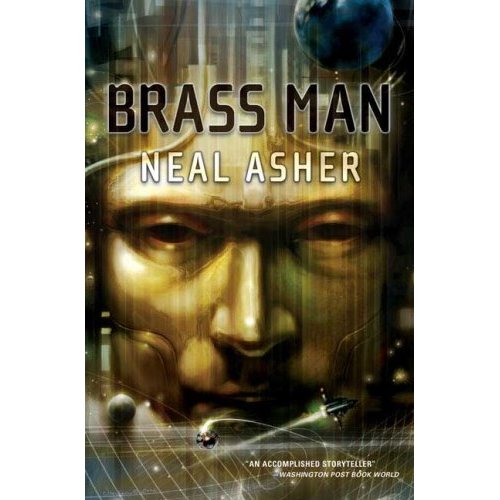Neal Asher, Brass Man
reviewed by Danielle L. Parker

Publisher: Tor, 2007
Length: 485 pages
ISBN: 13-978-0-765-31731-5
In Asher’s far future, humans no longer directly manage the affairs of men. Artificial intelligences who have stepped from the role of servant to mentor rule the joint worlds of the Polity, and humans are just one, often lesser, entity among the many in their charge. But both humans and their artificial partners are vulnerable to the killer technologies of the mysterious and long-vanished Jain. As advanced as the cybernetic and genetic sciences of this future age are, they are crude caveman arts compared to what the mysterious Jain left behind. Any being with the tiniest modicum of computing power — organic or non-organic — is vulnerable. To make matters worse, no one knows the goal of these alien artifacts... except it’s clear that they have a goal of some kind, and it might just be to devour civilization as humans and AI presently know it.
The knowledge and power represented by the Jain technologies is, of course, temptation. As the story opens, an asteroid with Jain artifacts has just been found. Unfortunately, someone reached it before the representatives of the Polity, and a man that Earth Central Security agent Ian Cormac thought he had left for dead is now on the loose, infested with Jain technologies. The escapee, Skellor, is now a nearly invulnerable monster whose purpose — subverted by his infestation of Jain technologies — cannot be easily guessed. To make matters worse, he has a brass slave, a Golem called Mr. Crane, whose own killing powers are enhanced by the spreading infestation. The combination is a little more than Ian Cormac finds comfortable, even with a AI killer ship named Jack Ketch (who has a disquieting fondness for execution devices in his décor) as his partner.
Brass Man is a sequel to earlier works in the series, and if possible, I would advise beginning at the beginning. Asher’s epic is certainly complex, and the readers who start in with Brass Man, as I did, may find themselves struggling with multiple story lines and secondary characters. There are far too many plotlines and semi-independent threads to summarize here. The fact that the chief villain is first introduced off-stage in a previous book posed a problem, as we never see the character development arc — by the time we meet Skellor, he’s simply a crazed ghoul run amok.
But don’t let those minor difficulties stop you. Parts of Brass Man were good enough that I read them twice. The battle between the Jack Ketch and its erstwhile allies (raising again the question of the possible non-relationship between intelligence and morality) was one. There are more. Neal Asher was a new author to me, but I’ll be on the lookout from now on. His next book certainly won’t escape me!
Copyright © 2007 by Danielle L. Parker

